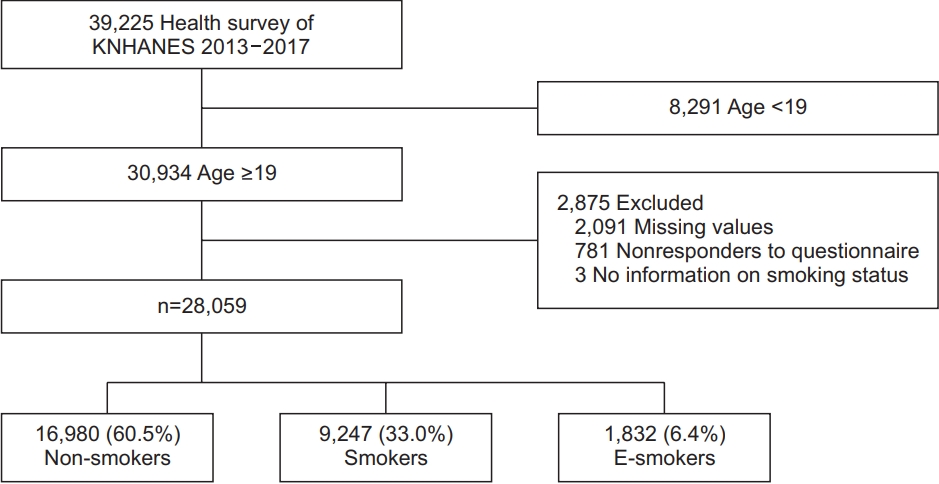 |
 |
| Tuberc Respir Dis > Volume 84(2); 2021 > Article |
|
Abstract
Background
Methods
Results
Notes
AuthorsŌĆÖ Contributions
Conceptualization: Kim JY, Choi HS. Methodology: Jung JW, Park HJ, Park JS. Formal analysis: Jung JW, Park JS, Jung SY. Data curation: Park JS, Park JH, Park DI, Chun EM. Software: Park J. Validation: Choi HS. Investigation: Kim JY, Choi HS, Jung JW, Park HJ, Park JS, Park J, Park JH, Park DI, Chun EM, Lee SH. Writing - original draft preparation: Kim JY. Writing-review and editing: Kim JY, Choi HS, Jung JW, Park HJ, Park JS, Park J, Park JH, Park DI, Chun EM, Lee SH. Approval of final manuscript: all authors.
Figure┬Ā1

Figure┬Ā2

Table┬Ā1
| Characteristic | Non-smoker (n=16,980, 60.5%) | Smoker (n=9,247, 33.0%) | E-smoker (n=1,832, 6.4%) | p-value* |
|---|---|---|---|---|
| Male sex | 2,721 (16.0) | 7,772 (84.0) | 1,576 (86.0) | <0.001 |
| Age, yr | 50.8┬▒17.04 | 53.43┬▒15.75 | 39.73┬▒14.11 | <0.001 |
| Conventional cigarette | <0.001 | |||
| ŌĆāNon | 16,980 (100) | 0 | 51 (2.8) | |
| ŌĆāFormer | 0 | 5,437 (58.8) | 342 (18.7) | |
| ŌĆāCurrent | 0 | 3,810 (41.2) | 1,439 (78.5) | |
| Smoking amount, PY | 0 | 23.93┬▒24.55 | 23.84┬▒23.36 | <0.001 |
| Household income | <0.001 | |||
| ŌĆāLowest quartile | 3,313 (19.6) | 1,901 (20.6) | 209 (11.4) | |
| ŌĆāLower middle quartile | 4,162 (24.6) | 2,537 (25.6) | 439 (24.0) | |
| ŌĆāUpper middle quartile | 5,433 (26.8) | 2,494 (27.1) | 601 (32.9) | |
| ŌĆāHighest quartile | 4,896 (29.0) | 2,460 (26.7) | 577 (31.6) | |
| Level of education | <0.001 | |||
| ŌĆāŌēżElementary school | 4,204 (25.7) | 1,741 (19.8) | 115 (6.6) | |
| ŌĆāŌēżMiddle school | 1,586 (9.7) | 1,089 (12.4) | 132 (7.6) | |
| ŌĆāŌēżHigh school | 5,084 (31.1) | 2,939 (33.4) | 795 (45.7) | |
| ŌĆāŌēźCollege | 5,457 (33.4) | 3,020 (34.4) | 697 (40.1) | |
| Comorbidity | ||||
| ŌĆāAsthma | 536 (3.3) | 247 (2.8) | 45 (2.6) | 0.095 |
| ŌĆāHypertension | 3,866 (23.2) | 2,424 (26.8) | 230 (12.8) | 0.677 |
| ŌĆāDiabetes | 1,420 (8.5) | 1,032 (11.4) | 115 (6.4) | <0.001 |
| ŌĆāLung cancer | 13 (0.1) | 29 (0.3) | 3 (0.2) | 0.092 |
Table┬Ā2
| Smoker | E-smoker | OR(╬▓) | 95% CI | p-value* | |
|---|---|---|---|---|---|
| Time to the first cigarette after waking up, min | ŌłÆ0.396 | <0.001 | |||
| ŌĆāŌēż5 | 155/782 (19.8) | 109/346 (31.5) | |||
| ŌĆā6-30 | 240/782 (30.7) | 99/346 (28.6) | |||
| ŌĆā31-60 | 104/782 (13.3) | 69/346 (19.9) | |||
| ŌĆā>60 | 283/782 (36.2) | 69/346 (19.9) | |||
| Plan to quit smoking within 6 months | 1,360/3,808 (35.7) | 563/1,439 (39.1) | 1.233 | 1.041-1.462 | 0.016 |
| Did not smoke for more than 1 day in the last year | 1,354/2,390 (56.7) | 550/905 (60.8) | 1.237 | 1.013-1.510 | 0.037 |
Table┬Ā3
| Non-smokers (n=16,966) | Smokers (n=9,239) | E-smokers (n=1,832) | p-value* | Non-smokers vs. E-smokers | Smokers vs. E-smokers | |||||
|---|---|---|---|---|---|---|---|---|---|---|
|
|
|
|||||||||
| OR(╬▓) | 95% CI | p-value* | OR(╬▓) | 95% CI | p-valueŌĆĀ | |||||
| Perceived stress | 0.001 | ŌłÆ0.075 | <0.001 | ŌłÆ0.023 | 0.072 | |||||
|
|
||||||||||
| ŌĆāVery much | 741 (4.4) | 420 (4.5) | 128 (7.0) | |||||||
|
|
||||||||||
| ŌĆāA lot | 3,481 (20.5) | 1,928 (20.9) | 534 (29.1) | |||||||
|
|
||||||||||
| ŌĆāA little | 9,792 (57.7) | 5,250 (56.8) | 980 (53.5) | |||||||
|
|
||||||||||
| ŌĆāHardly | 2,952 (17.4) | 1,641 (17.8) | 190 (10.4) | |||||||
|
|
||||||||||
| Depressive episode | 1,338 (13.2) | 634 (11.4) | 163 (14.2) | <0.001 | 1.957 | 1.560-2.456 | <0.001 | 1.344 | 1.043-1.733 | 0.022 |
|
|
||||||||||
| Experience of counseling in a psychiatric clinic | 386 (3.5) | 187 (3.2) | 42 (3.2) | 0.007 | 1.169 | 0.784-1.743 | 0.443 | 0.878 | 0.585-1.318 | 0.531 |
|
|
||||||||||
| Suicidal ideation | 481 (4.7) | 324 (5.8) | 74 (6.5) | <0.001 | 1.569 | 1.839-3.588 | <0.001 | 1.363 | 0.951-1.953 | 0.092 |
|
|
||||||||||
| Suicidal plan | 183 (1.3) | 138 (1.8) | 38 (2.4) | <0.001 | 3.220 | 2.001-5.181 | <0.001 | 1.944 | 1.223-3.092 | 0.005 |
|
|
||||||||||
| Suicide attempts | 67 (0.5) | 6 (0.9) | 18 (1.1) | <0.001 | 4.271 | 2.041-8.939 | <0.001 | 1.146 | 0.573-2.293 | 0.701 |
|
|
||||||||||
| Perceived stress (overall) | 4,222 (24.9) | 2,348 (25.4) | 662 (36.1) | <0.001 | 1.905 | 1.679-2.162 | <0.001 | 1.194 | 1.031-1.382 | 0.018 |
References
-
METRICS

-
- 0 Crossref
- 0 Scopus
- 12,080 View
- 131 Download
- ORCID iDs
-
Jae Yeol Kim

https://orcid.org/0000-0003-3631-4610Hye Seon Kang

https://orcid.org/0000-0002-2096-7679Hye Sook Choi

https://orcid.org/0000-0001-8387-4907 - Funding Information
-
Ministry of Health and Welfare
https://doi.org/10.13039/501100003625 - Related articles


 PDF Links
PDF Links PubReader
PubReader ePub Link
ePub Link Full text via DOI
Full text via DOI Print
Print Download Citation
Download Citation



